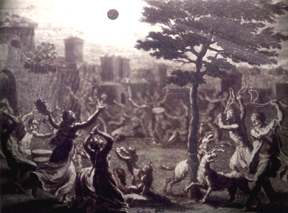Click on image for full size
Windows to the Universe original artwork by Randy Russell using an image from NASA's TRACE (Transition Region and Coronal Explorer) spacecraft.
Related links:
Movie: Journey Beneath a Sunspot
Movie: Magnetic Field Lines Tangle as Sun Rotates
Activity: Graphing Sunspot Cycles
Activity: Plotting Locations of Active Regions on the Sun
Activity: Tracking the Motion of an Active Sunspot Region
Movie: Supercomputer Models Help Scientists Understand Sunspots
Sunspots and Magnetic Fields
You probably have magnets on your refrigerator holding up some of your artwork or a photograph of a friend or family. Did you know that it is magnetic fields (which all magnets have) that make sunspots on the Sun?
The magnetic fields are like "ropes" that break through the "surface" (photosphere) of the Sun. Where the rope comes up from the solar surface is one sunspot and where the rope goes into the photosphere is another sunspot.
When the magnetic ropes get too twisted, they can pop! This lets off huge bursts of energy in solar flares and Coronal Mass Ejections (CMEs).














